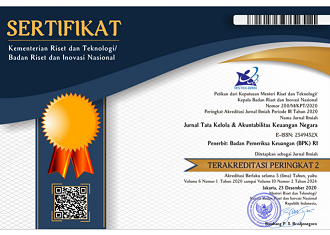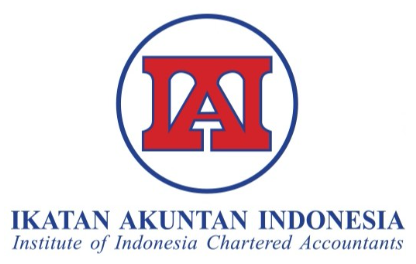THE AUDIT BOARD OF REPUBLIC OF INDONESIA OPINION AND BRIBERY IN LOCAL GOVERNMENTS IN INDONESIA
DOI:
https://doi.org/10.28986/jtaken.v5i2.379Keywords:
Corruption, bribery, audit, BPK’s opinion, capital expenditure, goods and services expenditureAbstract
This study is motivated by the trend of corruption cases which increase from year to year, where bribery is the first number in corruption cases. As many as 128 cases of bribery with in kracht status occurred in the local government that received an unqualified opinion from the Audit Board of the Republic of Indonesia (BPK RI). Using the Zero Inflated Poisson (ZIP) Panel Regression, this study examines the correlation between financial statement opinion and the number of bribery corruption cases based on 258 bribery cases that have been handled by the Corruption Eradication Commission (KPK) in the period 2008-2017. The estimation result shows that there was no correlation between financial statement opinion and the number of bribery cases. However, the increase in the amount of capital expenditure also goods and services expenditure is related to the increase in the number of bribery cases. This study recommends BPK to consider improving the quality of fraud detection through audit procedures on financial statements, especially in regions that have a relatively high value of capital expenditure and service goods expenditure.
References
Ball, R. (2001). Infrastucture requirement for an economically efficient system of public financial reporting and disclosure. Brooking-Wharton Papers on Financial Services, 169, 127–169. doi:10.1353/pfs.2001.0002
Bardhan, P. (1997). Corruption and development: A review of issues. Journal of Economic Literature, XXXV, 1320– 1346. doi: 10.4324/9781315126647-30
Becker, G. S. (1968). Crime and punishment: An economic approach. Journal of Political Economy University of Chicago, 75(2), 139–146.
Blume, L., & Voigt, S. (2011). Does organizational design of supreme audit institutions matter? A cross-country assessment. European Journal of Political Economy, 27(2), 215–229. doi: 10.1016/j.ejpoleco.2010.07.001
Bobonis, G. J., Fuertes, L. R. C., & Schwabe, R. (2015). Monitoring corruptible politicians. (December). Retrieved from: http://homes.chass.utoronto.ca/ ~bobonis/BCS_PRAudit_15-12.pdf
BPK RI. (2017). BPK Regulation Number 1 Year 2017 concerning State Financial Audit Standards (Peraturan Badan Pemeriksa Keuangan Republik Indonesia Nomor 1 Tahun 2017 tentang Standar Pemeriksaan Keuangan Negara). Retrieved from https://www.bpk.go.id/page/ standar-pemeriksaan-keuangan-negara
BPK RI. (2018). Ikhtisar Hasil Pemeriksaan Semester (IHPS) I Tahun 2018 (Summary of Semester Audit Results I Year 2018). Retrieved from https:// www.bpk.go.id/ihps
Cuervo-Cazurra, A. (2008). The effectiveness of laws against bribery abroad. Journal of International Business Studies, 39 (4), 634–651. doi: 10.1057/palgrave.jibs.8400372
Djankov, S., La Porta, R., Lopez-de-Silanes, F., & Shleifer, A. (2002). The regulation of entry. Quarterly Journal of Economics. 117(1), 1–37. doi: 10.1162/003355302753399436
Farooq, O., & Shehata, N. F. (2018). Does external auditing combat corruption? Evidence from private firms. Managerial Auditing Journal, 33(3), 267–287. doi: 10.1108/MAJ-082017-1634
Finan, F., & Mazzocco, M. (2016). Electoral incentives and the allocation of public funds. IZA, 9623, 1–55. doi: 10.1248/cpb.34.2774
Gaspar, V., & Hagan, S. (2016). Corruption: Costs and mitigating strategies international monetary fund fiscal affairs and legal departments authorized for distribution. Retrieved from http:// www.imf.org/external/pubs/ft/ sdn/2016/sdn1605.pdf
Goel, R., & Nelson, M. (1998). Corruption and government size. Public Choice, 97 (1–2), 107–120.
Gray, I., & Manson, S. (2008). The audit process (Fourth Edition). Tomphson Learning.
Greene, W. H. (1994). Accounting for excess zeros and sample selection in poisson and negative binomial regression models. Biology & Philosophy, 9(3), 265– 265. doi: 10.1007/ BF00857937
Gurgur, T., & Shah, A. (2005). Localization and corruption: Panacea
or pandora’s box? World Bank Policy Research Paper, 3486.
Hayes, R., Dassen, R., Schilder, A., & Wallage, P. (2005). Principles of auditing (2nd edition). Amsterdam.
Hopkin, J., & Rodríguez-Pose, A. (2007). “Grabbing hand” or “helping hand”?: Corruption and the economic role of the state. Governance, 20(2), 187–208. doi: 10.1111/j.1468-0491.2007.00353.x
Kassem, R., & Higson, A. W. (2016). External auditors and corporate corruption: Implications for external audit regulators. Current Issues in Auditing, 10(1), P1– P10. doi: 10.2308/ciia-51391
Khalil, W., Saffar, W., & Trabelsi, S. (2015). Disclosure standards, auditing infrastucture, and bribery mitigation. Journal of Bussiness Ethnics, 132(2), 379–399. doi: 10.1007/sl0551-014-2321-6
Khan, M. (2006). Role of audit in fighting corruption. ethics, integrity, and accountability in the public sector: Rebuilding public trust in government through the implementation of the UN Convention against corruption, (September), 1–32.
Klitgaard, R. (1988). Controlling corruption. Retrieved from https://www.jstor.org/ stable/10.1525/j.ctt1pnj3b.
KPK. (2018). KPK’s annual report of 2018 (Laporan tahunan KPK 2018). Retrieved on May 22 2019 from https:// www.kpk.go.id/images/Integrito/ LaporanTahunanKPK/LaporanTahunan-KPK-2018-.pdf
KPK. (2019). Graph of case handling December 2018 (Grafik penanganan perkara Desember 2018). (Unpublished document). KPK, Jakarta.
Labuschagne, H., & Els, G. (2006). Corruption and fraud: Any lesson for the auditor? Meditari Accountancy Research, 14 (1), 29–47. doi: 10.1108/10222529200600003
Lambert, D. (1992). Zero-inflated poisson regression, with an application to defects in manufacturing. Technometrics, 34(1), 1–14. doi: 10.1080/00401706.1992.10485228
Lanham, D. (1987). Criminal Fraud. Sidney: Law Book Co.
Lassen, D. D., & Alt, J. E. (2003). The political economy of institutions and corruption in American states. Journal of Theoretical Politics, 15(3), 341–365. doi: 10.1177/0951692803015003006
Law of The Republic of Indonesia Number 11 of 1980 concerning Bribery Crimes (Undang-Undang Republik Indonesia Nomor 11 Tahun 1980 tentang Tindak Pidana Suap). Retrieved from http:// ditjenpp.kemenkumham.go.id/arsip/ ln/1980/uu11-1980.pdf
Law of The Republic of Indonesia Number 15 Year 2004 concerning The State Financial Management and Accountability Audit (Undang-Undang Republik Indonesia Nomor 15 Tahun 2004 tentang Pemeriksaan Pengelolaan dan Tanggung Jawab Keuangan Negara). Retrieved from https:// www.kemenkeu.go.id/sites/default/ files/pdf-peraturan/uu%20nomot% 2015%20tahun%202004.pdf
Liu, J., & Lin, B. (2012). Government auditing and corruption control: Evidence from China’s provincial panel data. China Journal of Accounting Research, 5 (2), 163–186. doi: 10.1016/ j.cjar.2012.01.002
Neu, D., Everett, J., Shiraz, A., & Martinez, D. (20.13). Accounting, organizations and society accounting and networks of corruption. Accounting, Organizations and Society, 38(6–7), 505–524. doi: 10.1016/j.aos.2012.01.003
Osifo, C. (2012). Combating bribery as an issue of different dimensions. Working Papers 5 Public Management 4
(October 2012). Retrieved from
https://www.univaasa.fi/materiaali/ pdf/isbn_978-952-476-421-6.pdf
Porter, B. (1993). An empirical study of the audit expectation performance gap. Accounting and Business Research, 24 (93), 49–68.
Quah, J. S. T. (2016). Singapore’s success in combating corruption: Four lessons for China. American Journal of Chinese Studies, 23(2), 187–209.
Rose-Ackerman, S. (1999). Political corruption and democracy. Connecticut Journal of Int’L Law, 14(2), 363–378. doi: 10.3366/ajicl.2011.0005
Scully, G. W. (1991). Rent-seeking in U.S. Government budgets, 1900-88. Journal of Public Choice, 70, 99–100.
Seldadyo, H., & Haan, J. De. (2006). The determinants of corruption: A literature survey and new evidence. The Economist, 55, 1–60. Retrieved from http:// congress.utu.fi/epcs2006/docs/ D1_seldadyo.pdf
Shihata, I. F. I. (1997). Corruption-A general review with an emphasis on the role of the world bank. Penn State International Law Review, 15(3). Retrieved from http://elibrary.law.psu.edu/psilr/vol15/ iss3/2
Simarmata, R. T., & Ispriyanti, D. (2011). Penanganan overdispersi pada model regresi poisson menggunakan model regresi binomial negatif. Media Statistika, 4(2), 95–104. doi: 10.14710/ medstat.4.2.95-104
Soltani, B. (2007). Auditing, An international approach. Prentice Hall.
Tavits, M. (2010). Why do people engage in corruption? The case of Estonia. Social Forces, 88(3), 1257–1279. doi: 10.1353/ sof.0.0288
Wei, D. H., Qin, Z. Y., & Tang, S. Q. (2010). A research on the relation between the efficacy of government audit and the security of financial fund. Auditing Research, 3, 9–14.
Downloads
Submitted
Accepted
Published
How to Cite
Issue
Section
License

Jurnal Tata Kelola dan Akuntabilitas Keuangan Negara is licensed under
a Creative Commons Attribution-ShareAlike 4.0 International License




















